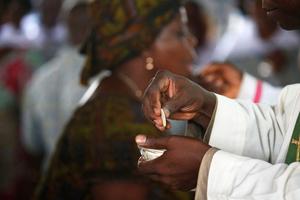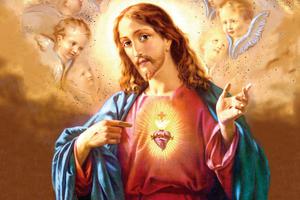Why (and How) to Restore First Friday Adoration at Your Parish
Recovering First Friday devotions can be a critical way to restore an awareness of the Eucharist as the ‘source and summit of the Christian life’

On Sept. 14, I recommended Catholic schools start an effort Oct. 7 taking school children to Mass on First Fridays through June so that, at least once in their lives, they would fulfill Our Lord’s request to St. Margaret Mary Alacoque to receive Holy Communion during that period. Our Lord promises to be with those who have done so at the hour of death, and the practice would serve young people well to shape their spiritual lives.
I always value my readers’ comments and feedback. “Karen” liked the article but urged parishes to observe First Fridays more broadly. I agree with her fully.
Let me recall a custom that used to be observed on First Fridays, which has fallen into disuse, but which merits revival: nocturnal adoration.
Nocturnal adoration is the Exposition of the Blessed Sacrament from sometime on First Friday evening through sometime on Saturday morning. I say “sometime” because I have seen varying customs, which I detail below.
Back in my native New Jersey in the 1960s and 1970s, “Nocturnal Adoration” was a monthly spiritual exercise, organized primarily by men’s societies (usually called “Holy Name” Societies) in various parishes. One parish was designated as the gathering parish. Men from the other parishes in town and one neighboring town took turns for one hour of adoration (“Could you not watch one hour with me? — Matthew 26:40, Jesus addressing his Apostles in the Garden of Gethsemane). The schedule changed every month, advancing one hour, so that everyone shared the opportunities (evenings) and challenges (middle of the nights).
Because we had nine Latin parishes in town plus three in neighboring towns, Exposition started after the 5:20pm evening Mass on Friday and ended at the 7:00am Mass on Saturday. Since often — but not always (e.g., not in October 2022) — First Fridays and First Saturdays coincide, many people used the opportunity to receive Communion according to the Nine First Fridays devotion and the Five First Saturdays devotion.
First Fridays Nocturnal Adoration was a devotion across the pre-1981 Diocese of Trenton: the diocesan newspaper used to print the parishes that were the sites for Exposition and the rotational schedule of the participating parishes.
The all-night devotion in Central New Jersey began petering off for several reasons. Pastors and parishes were not especially supportive of men’s societies, particularly in terms of encouraging younger members to back up the older. Consolidation of parishes reduced the number of churches that plugged into the local devotion. Concerns about crime at night — people going out and priests keeping their churches open — affected numbers. Beyond local conditions, there was also a flawed theology in the years immediately after Vatican II which depreciated Adoration, claiming it somehow “detracted” from the centrality of the liturgy, especially the Mass.
Well, (1) we want to encourage the Church as “community” and (2) there is no lasting Church “community” not grounded in the spiritual. (3) Growing numbers of parishes have recovered weekly Holy Hours or extended day of Exposition and (4) we have declared we want to “take back the night” from crime. As for whether Adoration “detracts” from the liturgy, one would hope that such callow thinking was put away long ago.
My own parish — St. James in Falls Church, Virginia — appears to be renewing this practice. For parishes that still don’t feel comfortable with a truly all-night vigil, I have seen churches that have trimmed Exposition back to 2am or even midnight (which imitates the way we normally observe Adoration of the reposed Blessed Sacrament on Holy Thursdays).
Exposition and Adoration can be begun in the evening as a Holy Hour. Better yet, why not have an evening Mass to launch the period? It reinforces both the Eucharist as adored and received.
Some parishes have observed First Friday Adoration in a usual, silent Holy Hour fashion. Others have blended the time with devotions (the Rosary or Chaplet of Divine Mercy). Some parishes have also used the time to schedule at least some window for sacramental Confession.
Spiritual talks might also be tailored to particular demographics in the parish, especially younger people or even children (say, the first hour Friday evenings). That would not be ill-advised given (1) we are losing young people who are becoming “nones” and (2) children need a message that going to Mass on a non-Sunday is not something extraordinary or burdensome (which is why I suggested the morning First Friday Masses in my earlier essay) and that the “weekend” is sealed against religion. I note that because, to the degree the “weekend” has replaced the Sabbath rest, it’s not just other religious activities (e.g., Holy Hours on First Fridays during the year, Stations of the Cross in Lent) but Sunday Mass itself that competes for a place in the sacrosanct “weekend.”
As “Karen” noted, her parish couples a meditative Holy Hour that is joined by students from the local college with some later subsequent social event. While that might not work with an all-night Vigil, it might with a limited Holy Hour. I’ll admit to being somewhat divided: there is nothing wrong with the community that starts at the Eucharist continuing afterward in the social, but I am also concerned that our proclivity to couple religious events with social follow-up (Mass and donuts) sometimes tends to diminish or rush the devotion for the social. Sometimes you just gotta pray. That is Catholic, too, and a spiritual discipline whose acquisition is necessary.
The bishops of the United States have recognized the need to encourage a Eucharistic revival, in part because survey information suggests a large number of Catholics simply do not understand what the Church teaches about Jesus and his Real Presence in the Blessed Sacrament. Recovering First Friday devotion can be a critical way to restore an awareness of the Eucharist as “the source and summit of the Christian life” (Vatican II, Dogmatic Constitution Lumen gentium, no. 11).

















